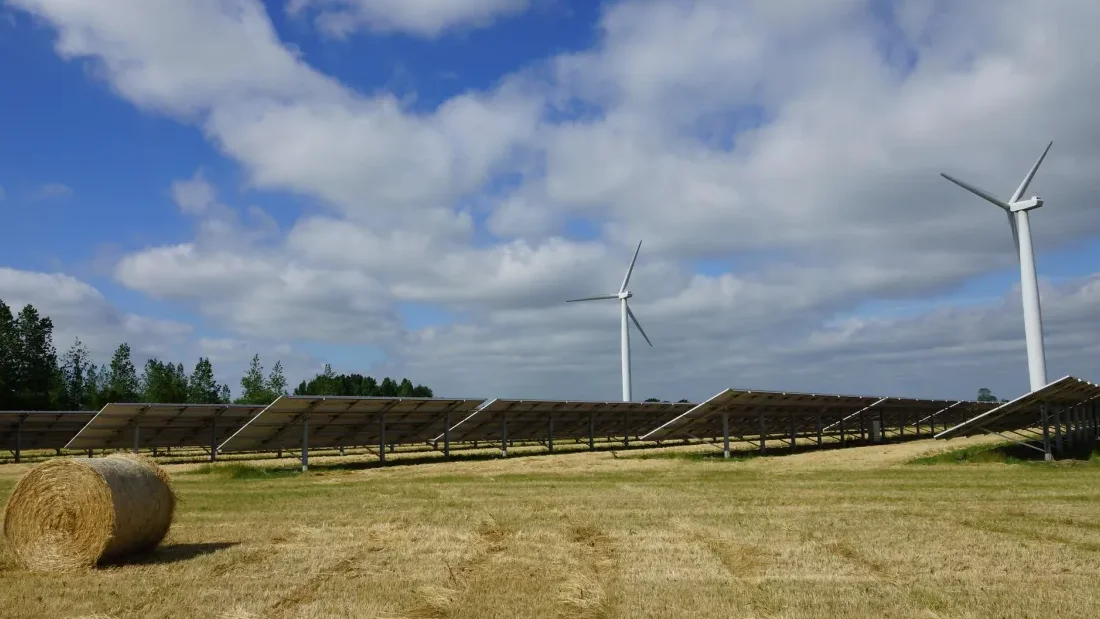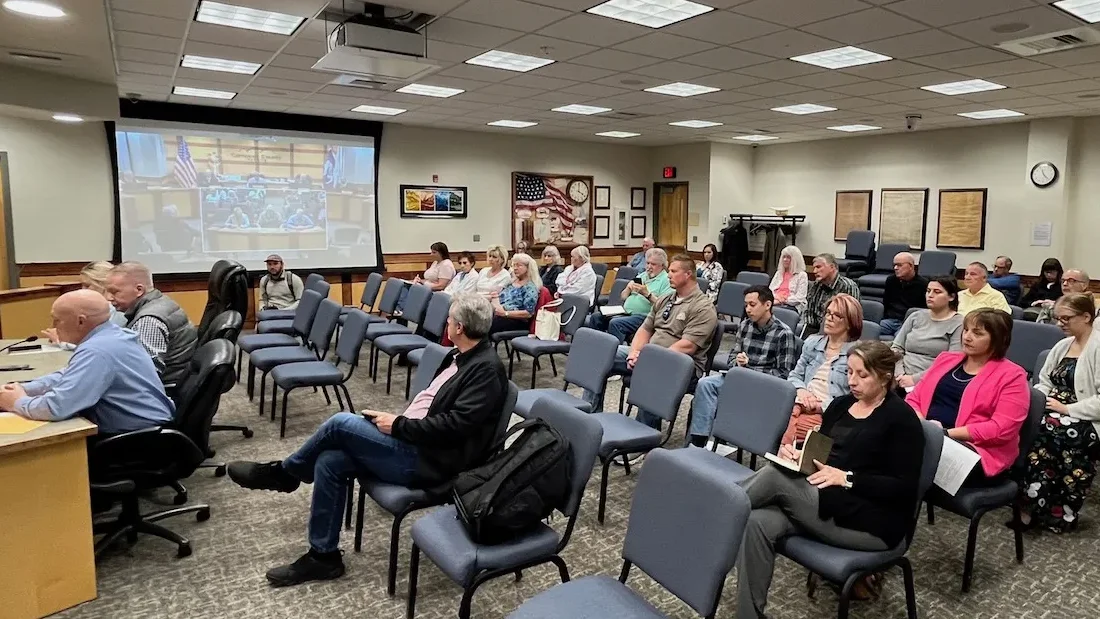
CLIMATE: Earth saw its hottest year on record in 2024, exceeding the previous year’s record and prompting a “red flag” warning from climate scientists as the planet surpassed the Paris Agreement’s 1.5°C warming threshold for the first time. (Associated Press)
SOLAR: Texas and California led the way on the record-breaking additions of 34 GW of new solar and 13 GW in battery storage across the U.S. last year, as 96% of all new generation capacity in 2024 was carbon-free. (Canary Media)
POLITICS:
GRID:
ELECTRIC VEHICLES: Analysts expect electric vehicle sales to jump 30% this year, even though the incoming Trump administration and its threat of tariffs and rolling back the EV tax credit and other incentives could slow the industry’s growth. (Associated Press)
OIL & GAS: Colorado regulators adopt first-in-the-nation rules requiring natural gas gathering and compression facilities to cut greenhouse gas emissions, but advocates say they lack enforcement parameters. (Colorado Sun)
COMMENTARY: Clean fuel standards can make states more independent from the federal government and generate revenue to fund electric vehicle charging infrastructure, the head of a Michigan business group writes. (Utility Dive)

EMISSIONS: Maine has become the latest state to sue major oil and gas companies, alleging they withheld information about the environmental impact of fossil fuels in order to pursue profit. (New York Times)
OFFSHORE WIND: A French energy company has paused its plans to build an offshore wind farm off New York and New Jersey for at least four years, citing President-elect Donald Trump’s opposition to wind as a major factor. (New York Post)
NUCLEAR:
FOSSIL FUELS
CLIMATE
TRANSMISSION:
ELECTRIC VEHICLES: A Vermont aviation company successfully completes a flight of its first electric plane, while the airport in nearby Plattsburgh, New York has been selected as the site for a test flight of the largest fully electric aircraft ever to take to the skies. (VTDigger, NBC5)
GRID: Advocates ask federal regulators to require a private equity firm planning to buy four power plants in PJM territory to disclose whether it plans to sell the energy to data centers, amid concerns the purchase could lead to “unreasonable rates” for customers. (Utility Dive)
COAL: Research out of Johns Hopkins confirms the presence of coal dust in a Baltimore neighborhood near a coal terminal, backing up residents claims that the particles coat their homes and cause health problems. (Baltimore Sun, subscription)

EFFICIENCY: A Michigan-based startup fabricating vacuum-insulated glass for highly efficient windows has opened a new manufacturing plant and secured nearly $83 million in capital and grants to scale up. (Canary Media)
TRANSPORTATION: Environmental advocates and health professionals call on Illinois regulators to adopt stricter tailpipe emission rules for cars and trucks that are modeled off of California’s and exceed national standards. (Chicago Tribune)
ELECTRIC VEHICLES:
SOLAR:
CARBON CAPTURE: A $2 billion carbon capture project at a North Dakota coal plant has been delayed after a key sponsor backs out and financing remains unclear. (E&E News, subscription)
UTILITIES: Investor-owned utilities in Indiana are seeking significant rate increases the “likes of which we’ve never seen,” consumer advocates say, to pay for clean energy and grid infrastructure upgrades. (Post-Tribune)

UTILITIES: Xcel Energy tells Colorado regulators that climate change, wildfire risk and litigation have prompted insurers to increase the utility’s premiums by nearly 400% over last year. (CPR)
ALSO: Wyoming lawmakers look to craft policies to attract more energy-intensive data centers to the state and help utilities deal with associated power demand increases. (WyoFile)
ELECTRIFICATION: A public-private partnership launches a project aimed at decarbonizing a Colorado manufactured-home community by replacing gas appliances with electric ones, bringing in solar power and making other efficiency upgrades. (Utility Dive)
ELECTRIC VEHICLES:
LITHIUM:
POLLUTION: Colorado advocates urge federal regulators to classify the state’s heavily populated Front Range as an “extreme” ozone violator following an abnormally smoggy summer. (CPR)
SOLAR:
CLIMATE:
POLITICS: U.S. Sen. Martin Heinrich, a New Mexico Democrat, touts his support for the SunZia transmission project in a campaign ad, signaling the party’s potential shift toward pushing clean energy infrastructure. (HuffPost)
CLEAN ENERGY: Advocates call on Alaska to tap into its largely unrealized clean energy potential after a report finds the state acquires 2.6% of its electricity from solar, wind and geothermal sources. (Renewable Energy World)

UTILITIES: A new Sierra Club evaluation finds for the fourth year in a row that major U.S. utilities are off track to meet the Biden administration’s emissions reduction goals, and many are in a worse position than last year due to rising demand. (Canary Media)
CLEAN ENERGY:
NUCLEAR: A U.S. Department of Energy report suggests a new serialized approach for designing and building nuclear reactors that would lower upfront costs and meet rising power demand. (Utility Dive)
GRID:
CLIMATE:
ELECTRIC VEHICLES:
OIL & GAS: Natural gas accounted for nearly half of the nation’s energy generation over the summer while coal fell to just 16%, leaving even West Virginia utilities considering a shift to gas. (West Virginia Public Broadcasting)
ELECTRIFICATION: California launches an $80 million program aimed at electrifying low and moderate-income households with rebates for heat pumps, appliances and efficiency upgrades. (Sacramento Bee)

CORRECTION: The owners of the Three Mile Island nuclear plant are seeking a $1.6 billion loan guarantee; an item in yesterday’s newsletter listed the wrong amount.
EMISSIONS: Global natural gas exports are responsible for far more emissions than coal exports, researchers find, concluding there is “no need for LNG as an interim energy source” as countries phase out coal. (The Guardian)
COAL:
NUCLEAR: Regulators and lawmakers should do more to make nuclear reactor licensing more accessible and craft regulations that allow existing reactors to support data centers and hydrogen producers, panelists say during a clean energy conference. (Utility Dive)
EQUITY: A solar technician training course in Boston aims to build a more diverse workforce to accelerate the rate of solar installations and help residents of underserved communities. (WBUR)
POLITICS:
OIL & GAS: ConocoPhillips signs a $300 million deal to acquire some of Chevron’s oil and gas facilities on Alaska’s North Slope, bucking the trend of large companies selling out to private firms. (Alaska Beacon)
CARBON CAPTURE: The U.S. Interior Department is two years behind in crafting rules for offshore carbon sequestration, but expects to finish this year. (E&E News)
HYDROGEN: The U.S. Treasury Department will finalize its clean hydrogen tax credit rules by the end of the year, a deputy secretary says. (Heatmap)

CLIMATE: An investigation finds Oregon-based Nike’s private jets’ greenhouse gas emissions have increased since the company first pledged to reduce its carbon footprint. (Oregonian)
CLEAN ENERGY:
OIL & GAS:
COAL: An international commission considers tighter regulations on Canada coal mines accused of contaminating a river that crosses the border into Idaho. (Idaho Capital Sun)
URANIUM: Arizona’s attorney general calls on federal agencies to update a controversial Grand Canyon-era uranium mine’s decades-old environmental review and apply new science to potential groundwater impacts. (news release)
POLLUTION: California advocates support the San Diego port’s efforts to reduce pollution that disproportionately affects disadvantaged communities, but some say it may be too little too late. (Next City)
WIND: The federal Bureau of Ocean Energy Management finds proposed wind leasing off Oregon’s coast will have no significant environmental impacts. (KOBI 5)
SOLAR:
STORAGE:
COMMENTARY:

CLIMATE: A compilation of government documents shows climate change was discussed in Congress and the media in the 1960s and 1970s, including a Nixon administration report that said “the greatest consequences of air pollution for man’s continued life on earth are its effects on the earth’s climate.” (Grist)
ALSO: The research, compiled by historian Naomi Oreskes, contradicts assertions in recent Supreme Court rulings that climate change was not a topic of concern when the Clean Air Act was passed in 1970. (Inside Climate News)
UTILITIES: Hawaiian Electric and six other entities agree to pay $4 billion in damages to settle lawsuits stemming from last year’s deadly Maui wildfires. (CNN)
ELECTRIFICATION: Nearly $500 million in federal funding will help encourage heat pump adoption in Alaska and New England. (Canary Media)
COAL:
GRID: An Exelon executive says the record-high prices awarded in PJM Interconnection’s latest capacity auction could lead to double-digit rate increases for some of its utilities. (Utility Dive)
ELECTRIC VEHICLES:
SOLAR: Michigan farmers seeking additional revenue through solar leases are backed by a new state law that gives state regulators greater oversight in the event of local opposition. (Bloomberg)
POLITICS:
COMMENTARY: A utility-funded California program relies on innovative approaches to help low-income homeowners take advantage of electric heat pump rebate programs. (CalNEXT, sponsored)

HYDROPOWER: A study finds climate change-exacerbated drought has diminished hydropower production in Western states, leading to billions of dollars in economic losses and increased natural gas generation. (Energy Mix)
SOLAR: A Hawaii cooperative establishes a community-owned solar system aimed at bringing down power prices and achieving energy sovereignty. (Grist)
GRID:
MINING:
UTILITIES:
WIND: West Coast advocates join other groups to form a national coalition aimed at pushing back on offshore wind development. (E&E News, subscription)
BIOFUELS: A northern California nonprofit secures financing for a proposed 5 MW biomass plant that would process forest restoration project waste. (Renewable Energy)
CLIMATE:
CARBON CAPTURE: Calpine enters a cost-share agreement with the U.S. Energy Department to fund a carbon capture demonstration project at a natural gas plant in California. (Power Engineering)
PUBLIC LAND: The federal Bureau of Land Management issues a proposed plan that would guide renewable energy development and oil and gas drilling on 730,000 acres in New Mexico. (news release)

The following commentary was written by Larry Glover, a Maryland-based energy marketing & communications SME. See our commentary guidelines for more information.
This heat wave is only the beginning. As climate disasters and extreme weather events become more frequent, ensuring reliable and affordable access to electricity for all communities has never been more urgent. Places that we typically think of as pleasant in the summer months are becoming heat domes, and many electricity providers remain overwhelmed when their peak energy demand threatens the stability of the entire electric grid.
Clean, distributed, energy resources such as solar and batteries are anchoring our country’s electric grid in the face of extreme summer heat. And while the federal government has a duty here, state policymakers and regulators hold an immense amount of power to pave the way for these clean energy technologies.
Let’s start with the good news. Several states are beginning to realize the need for clean energy – both out of protecting energy users from losing power during extreme weather and as an equitable path forward. I’m heartened to see that Maryland is the latest state to heed those calls to action by enacting key legislation that will tackle this challenge head-on, establishing an equitable path toward a sustainable energy future.
This year, Maryland passed a trio of bills — signed by Gov. Wes Moore — to expand access to solar, stimulate the solar industry and require utilities to leverage distributed energy resources that will ultimately benefit underserved communities, which suffer the most from high-energy burdens and pollution. The Brighter Tomorrow Act directs the Maryland Energy Administration to earmark tens of millions of dollars in the coming years to provide upfront grants for low and moderate-income households across the state to install solar. The Drive Act, encourages utilities to harness these home solar and battery systems into virtual power plants (VPPs), which are networks of connected solar and battery systems that function as a unified power source. Finally, the Empower Act ensures those who invest in home batteries are fairly compensated, allowing people to invest in these resources to take care of their neighbors.
There’s not a one-size-fits-all approach to state policy promoting distributed energy, and other states have taken alternative routes. In Illinois, the Climate and Equitable Jobs Act (CEJA), designed to cut emissions across the state, encouraged a rooftop solar boom since its 2021 passage. Texas is on California’s tail for solar and storage, bolstered by a VPP pilot program approved by ERCOT last year.
Unfortunately, for every state or region moving forward, others are moving back. Cuts to the net-metering program in California have caused the solar industry to contract to 2014 levels, and cost 17,000 jobs. Puerto Rico, a territory that is perhaps most in need of solar and storage as it faces frequent heat waves and hurricanes threatening the electric grid, also has net metering on the chopping block, with hurricane season barely underway. It’s truly mind-boggling.
Through the hottest summer many of us have experienced, every state is grappling with the escalating consequences of climate change. As the White House, rightfully, continues to prioritize environmental justice initiatives, our state governments also have a duty to incentivize and enable clean energy resources. Our grid and our lives depend on it.